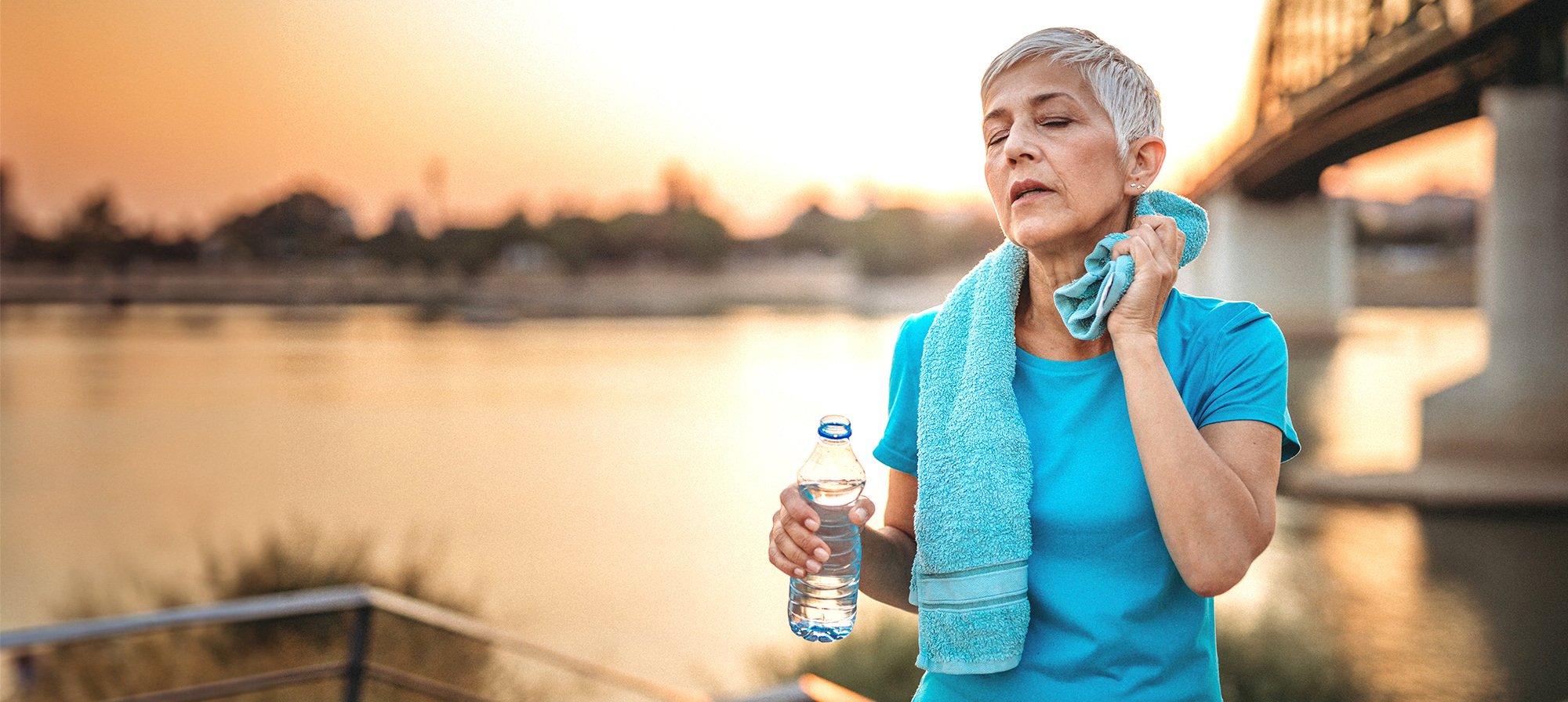As the days grow hotter, it’s crucial to prepare for extreme heat and to know the signs of heat-related illness. Keep your cool with these heat safety tips.
Long, hot days and changing temperatures have become part of the everyday shifts in weather. But what happens when these hot days become hotter and heat waves become more frequent and longer lasting?
When you think of dangerous weather, disasters like hurricanes, wildfires, and floods may come to mind. But extreme heat has become one of the most dangerous weather conditions in recent years.
Extreme heat is more than just unpleasant. If proper heat safety precautions aren’t taken, hot weather can put you at risk for heat illness. Fortunately, the health effects of high heat are also the most preventable.
Extreme heat is defined as 2 to 3 days of temperatures above 90°F, often coupled with high humidity. When these heat waves roll in, you may need to drink more water or take your workout to the pool, just for starters. Making simple heat safety changes like these, as well as others, can help prevent heat illnesses.
 Heat-related illness
Heat-related illness
Extreme heat raises the risk of heat exhaustion and its potentially fatal cousin, heatstroke. You’ve most likely heard of these conditions—but how are they different? And what other problems should you be aware of?
A heat illness happens when your body fails to cope with high heat and humidity. High humidity prevents sweat from evaporating quickly enough for the body to cool down. But taking precautions is still crucial in dry climates, especially when the heat index is above 90ºF. The human body functions best in temperatures ranging from 65ºF to 75ºF. So extreme heat can overwhelm your body’s adaptive responses, causing these 5 illnesses:
- Heat exhaustion
- Heatstroke
- Dehydration
- Heat rash
- Heat cramps

1. Heat Exhaustion
This often happens if you’ve been in hot weather for a long time without hydrating. Unlike heatstroke, heat exhaustion usually improves quickly after resting in a cool place and drinking fluids. But without taking these steps, heat exhaustion can lead to the more serious consequence—heatstroke.
To prevent heat exhaustion from transitioning to heatstroke, call your doctor, 911, or go to the emergency room if your symptoms don’t go away after one hour. In fact, if you’re alone, and start to feel even a few of the symptoms below, even if they’re mild, get the attention of a passerby in the area or call a friend to come help you.
Heat exhaustion can be identified by these symptoms:
- Dizziness and fainting
- Weakness and poor coordination
- Intense thirst
- Decrease in urination
- Heavy sweating and cool skin
- Quick, shallow breathing
- Muscle cramps
- Headache and irritability
- Elevated body temperature
- Weak but quick pulse
- Nausea, vomiting, and diarrhea

2. Heatstroke
This occurs when your body temperature rises above 106ºF within 10 to 15 minutes and your sweating mechanism fails. The rapid temperature spike and lack of sweat leaves the body unable to cool itself. Heatstroke can lead to organ failure, permanent disability, or death if not treated.
If you’re the one stricken with any of the symptoms below, and you’re alone, it’s critical to get help. Call 911 right away or get the attention of a passerby in the area and ask them to call 911 immediately. Then ask your helper to get you into a cool area while you wait for help to arrive. If you’re the one helping someone else with heatstroke, call 911 and then administer first aid to the victim, if you notice any of these symptoms:
- Body temperature of 105ºF or higher
- Quick, strong pulse
- Lack of sweating
- Hot, red skin
- Nausea
- Hyperventilation
- Muscle twitches
- Decline in mental state including confusion, slurred speech, or hallucinations
- Seizures
It’s critical to know the difference between the less serious heat exhaustion and the more serious heatstroke; the latter of which is a medical emergency. You can tell the 2 heat illnesses apart based on how your skin reacts:
- Cool skin and heavy sweating point to heat exhaustion.
- Hot, dry skin suggests heatstroke.
Treating heatstroke. While you wait for medical aid, cool the victim rapidly. Loosen or remove tight clothing then elevate the feet. Spray the victim with cool water from a hose. Or, if possible, immerse the victim in a tub of cool water. If that’s not an option, cover the body in cool, wet towels. Focus on spots where large blood vessels lie close to the skin’s surface, such as the back and sides of the neck, under the arms, and along both sides of the groin. Continue cooling the victim until the body temperature drops below 102ºF.
If the victim is conscious and able to swallow, give them small drinks of cool water. But avoid sugary or caffeinated fluids and ice-cold drinks. Make sure they are supervised. Most people, who get immediate help for heatstroke, do not die from it. When they receive prompt and adequate treatment, recovery is very likely.

3. Dehydration
This is a familiar feeling to many people. In fact, an estimated 75 percent of Americans do not drink enough water each day. So, improving your water intake is extremely important when it comes to staying safe in the heat.
Severe heat can cause more severe dehydration. Your body becomes dehydrated when it doesn’t have enough fluid to function normally. Keep in mind that if you feel thirsty, you’re already slightly dehydrated. Symptoms of dehydration include:
- Headache
- Dizziness
- Extreme thirst
- Fatigue
- Flushed skin
- Dark urine
Treating dehydration. Avoid these symptoms by drinking water before feeling thirsty. Aim for 2-3 liters per day. You may need to drink more depending on the heat, your activity levels, and other factors.
For example, dehydration is more common in older adults. But all human bodies are 50 to 75 percent water. Water plays a key role in supporting your organs, blood flow, bone health, and more. So, if you’re not hydrated, it’s hard enough to function in normal weather let alone in sweltering heat.

4. Heat Cramps
These are more likely to develop if you engage in strenuous work or exercise in the heat. Your body loses electrolytes such as salt and potassium when you sweat, which can cause painful muscle or abdominal cramps. Heat cramps may also be a sign of heat exhaustion. Symptoms include:
- Muscle pain and/or spasms in the legs, arms, or abdomen
- Cool, moist skin
- Body temperature stays normal
Treating heat cramps. Make sure to rest, drink water, and cool off. Drinking fluids with electrolytes can also ease cramps. But avoid salt tablets as they can worsen dehydration. (Learn why drinking too many electrolyte-enhanced sports drinks can actually be dangerous for your health .) Get medical help if the cramps do not subside within one hour of taking these steps. Medical help may also be needed if the victim is on a low sodium diet or has heart problems.

5. Heat Rash
This appears as a bright red skin irritation. It can happen when sweat gets trapped under your skin, often where it creases. The sweat blocks your sweat glands and leads to a rash. Here are some of the other signs of heat rash:
- Red, itchy skin
- Tingling pain
- Small bumps or blisters in skin folds or areas that stay wet with sweat such as your armpits, groin, neck, underneath your breasts, and inside your elbows
- Infection
Treating heat rash. Mild rashes often go away on their own. But visit your healthcare provider if the rash doesn’t get better after 3 to 4 days.
Who is at risk of heat-related illness?
Everyone is vulnerable to the dangers of severe heat, but the main people at risk are children under 4 and adults over 65. People over 65 have a harder time telling when they’re thirsty and lose more fluid than others. This means that older adults are 20 to 30 percent more prone to dehydration , which can increase the risk of heatstroke or exhaustion.
Other at-risk groups include those with cardiovascular disease, lung disease, or cerebral-vascular disease. The side effects of extreme heat are also more common in people who are overweight or have a chronic illness. Some studies suggest that a high core temperature can even impair the immune system, which may induce inflammation.
Extreme heat can also worsen existing health conditions. The following problems may be triggered or worsened by high heat:
- Stroke
- Heart attack
- Kidney problems
- Asthma and other respiratory illnesses (especially in air pollution or smoke)
Many factors affect how well your body can cope with heat. Talk to your doctor if you’re concerned about any existing conditions and heat exposure. Taking the right precautions can help prevent negative side effects. No matter your age or state of well-being, you put your health at risk the moment you step outside if you aren’t prepared.

Take these safety precautions to prevent heat illness during a heat wave
When heat illness strikes, it’s critical to know the steps to take to recover. But you can take steps to prevent heat illnesses from happening in the first place.
A hot, sunny day may seem like the perfect time to visit the beach or enjoy some sun. But if the humidity is above 60 percent and it’s hotter than 90°F, you might want to make new plans. Head to a shady park or find activities to do indoors where there is air conditioning (AC).
It’s also important to understand the types of heat alerts from The National Weather Service (NWS) .
- Excessive heat warnings are issued 12 hours before the onset of extreme heat.
- Heat watches are sent when the weather suggests a heat event is likely in the next 2-3 days.
- Heat outlooks are issued when excessive heat is likely in the next 3-7 days.
- Heat advisories tell us that temperatures are expected to be 100°F or higher for at least 2 days.
Watch for these alerts so you have time to prepare for extreme heat. Also, if you are unable to afford the cost of AC in your home, contact the Low Income Home Energy Assistance Program (LIHEAP) for help.
Then follow these additional tips to stay safe and comfortable:
- Limit your outdoor activity and stay indoors in AC if possible. Do not rely on fans in the case of extreme heat. Fans create air flow but do not reduce body temperature. If you have fans but no AC, take frequent cool showers or spray your body with a spray bottle of water you keep in the fridge in addition to using fans.
- Wear loose, lightweight, and light-colored clothing.
- Try to stay in the shade when you’re outside. Wear a broad brimmed hat.
- Stay hydrated by drinking water before you get thirsty.
- Exercise in the early morning or evening hours. Or stick to indoor workouts. And try to run your errands during these cooler times, too.
- Put together an emergency car kit to have on hand during your summer outings. This is especially helpful in case of a power outage.
- If you can, park your car in the shade to keep it cool. If it’s 80°F outside, the car interior will increase to 100°F within 10 minutes. Pets, children, and people over 65, especially, should never stay in a hot car—even if parked in the shade with the windows rolled down.
- Use blackout curtains and window awnings to help keep the house cool.
- Keep skin wet with a spray bottle, cool showers, swimming, etc. Try a cooling towel if the weather isn’t too humid. When soaked in water, these towels stay cool for longer.
- Use this extreme heat safety checklist from the Red Cross for additional tips.
With these heat safety tips in your toolkit, you can lower your risk of heat illness and help others do the same. Protecting your health will allow you to have fun all summer.
Check in on your loved ones, too, as these tips may protect them as well. And if you or anyone you encounter shows signs of severe heat illness, call 911 or go to your closest emergency room right away.

Not a Silver&Fit® member? Learn more about everything the program has to offer, including more helpful healthy living tips like this, here on our website.
This information is not intended to take the place of regular medical care or advice. Please check with your doctor before using this information or beginning any self-care program. Images used for this article do not depict any members of the Silver&Fit Program.
References
American Redcross. (n.d.). Extreme heat safety. Www.redcross.org. https://www.redcross.org/get-help/how-to-prepare-for-emergencies/types-of-emergencies/extreme-heat-safety.html
American Veterinary Medical Association. (n.d.). Estimated vehicle interior air temperature v. elapsed time. https://www.avma.org/resources/pet-owners/petcare/estimated-vehicle-interior-air-temperature-v-elapsed-time
Centers for Disease Control and Prevention. (2024, May 16). Extreme Heat and Your Health. https://www.cdc.gov/extreme-heat/about/index.html
Centers for Disease Control and Prevention. (2024, May 15). Symptoms of Heat-Related Illnesses. https://www.cdc.gov/extreme-heat/signs-symptoms/?CDC_AAref_Val=https://www.cdc.gov/disasters/extremeheat/warning.html
Centers for Disease Control and Prevention. (2024, May 15). Preventing Heat-Related Illness. https://www.cdc.gov/extreme-heat/prevention/?CDC_AAref_Val=https://www.cdc.gov/disasters/extremeheat/faq.html
Cleveland Clinic. (2023, June 5). Dehydration. https://my.clevelandclinic.org/health/diseases/9013-dehydration
Cleveland Clinic. (2023, June 19). Can you drink too many electrolytes? https://health.clevelandclinic.org/too-many-electrolytes
Cleveland Clinic. (2021, April 1). Heat illness: Symptoms, causes, treatments. https://my.clevelandclinic.org/health/diseases/16425-heat-illness
Harvard T.H. Chan School of Public Health. (2019, August 20). Climate change, heatwaves, and health. https://hsph.harvard.edu/research/climate-health-c-change/climate-kids-and-health/heat-and-health/
Mayo Clinic. (2022, June 25). Heatstroke. https://www.mayoclinic.org/diseases-conditions/heat-stroke/diagnosis-treatment/drc-20353587
National Weather Service; National Oceanic and Atmospheric Association. (n.d.). Heat watch vs. warning. https://www.weather.gov/safety/heat-ww
New York-Presbyterian Hospital. (2023, July 10). Placement of ice bags for heatstroke. https://www.nyp.org/healthlibrary/multimedia/placement-of-ice-bags-for-heatstroke
Occupational Safety and Health Administration. (n.d.). Heat - heat-related illnesses and first aid. https://www.osha.gov/heat-exposure/heat-illness
Presbitero, A., Melnikov, V. R., Krzhizhanovskaya, V. V., & Sloot, P. M. A. (2021). A unifying model to estimate the effect of heat stress in the human innate immunity during physical activities. Scientific Reports, 11(1), 16688. https://doi.org/10.1038/s41598-021-96191-0
Ready.gov. (2023, September 23). Extreme heat. https://www.ready.gov/heat
Services, D. of H. & H. (2023, May 12). How to cope and stay safe in extreme heat. Www.betterhealth.vic.gov.au; Department of Health, State Government of Victoria, Australia. https://www.betterhealth.vic.gov.au/health/healthyliving/how-to-cope-and-stay-safe-in-extreme-heat#how-you-can-help-others
Taylor, K., & Jones, E. B. (2022, October 3). Adult dehydration. PubMed; StatPearls Publishing. https://www.ncbi.nlm.nih.gov/books/NBK555956/
United States Environmental Protection Association (EPA). (2016, July 1). Climate change indicators: Heat-Related deaths. https://www.epa.gov/climate-indicators/climate-change-indicators-heat-related-deaths
This article was written by Celina Johnson, edited by Gail Olson, and clinically reviewed by Elizabeth Thompson, RDN, MPH on March 25, 2024.





